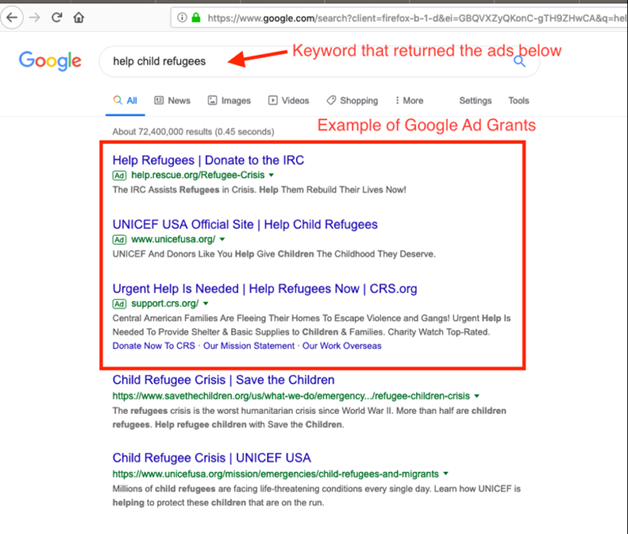What Are Google Ads And Google Ad Grants?
Google Ads is an online Google advertising platform designed to give advertisers an online outlet to market their products or services. Advertisers pay to display brief advertisements to prospective customers. Advertisers can choose what to advertise, where to advertise, and how much they want to spend.
First, you start by creating a Google Ads account and then adding words or phrases that when someone inputs into a search query could trigger your ad to be displayed. For example, if you are an attorney looking to grow your practice, you could input words such as ‘tax attorney’, ‘criminal attorney’, ‘pro bono attorney’ etc. When someone searching to hire an attorney, inputs any of the words you chose, could trigger your ad to show in their search query as displayed below in the Search Engine Results Page (SERP):

Obviously, there could be dozens of companies using the same keywords, vying to have their ads show in the few allotted spots. Whose ads are ultimately shown is determined by an evolving algorithm that evaluates ad relevance to the search query, the relevance of the landing page to the search query and the amount the organization is willing to pay to have your ads displayed.
How much your organization pays is determined by your overall Quality Score. Quality Score is simply an estimate of the quality of your ads, keywords, and landing pages.
The algorithm Google uses to determine cost and placement is called Ad Rank. It is calculated as follows:
A high-quality score is extremely important because it leads to cheaper costs per click, better positioning, and that, in turn, leads to more people going to your website.
Table of Contents
ToggleHOW TO RUN AN EFFECTIVE CAMPAIGN
- Invest the time and resources to fully understand your audience. Look at the types of sites your target audience spends time on. Research competitors and what sort of campaigns they are running.
- Set clearly defined goals and establish ways through which these goals can be measured to make sure that you are getting a reasonable ROI.
- Create a targeted landing page for your ad. That means designing landing pages with a single purpose, with one conversation goal and a clear path to that goal for the user to follow. In other words, your landing page should address the user’s query directly, without distractions, and have a call to action or what you want the user to do when they land on your page.
- It is a good practice to create many versions of your ad copy. Slight variations in ad copy can have a significant impact on conversation rates. By testing the many variations, you can quickly determine which versions convert best. The data you gather allows you to optimize your campaign for the best possible ROI.
- It is important that you understand that the work of running a campaign once set up is never done. Once it is up and running, you will have to make constant adjustments because even a small improvement in ROI can have a significant impact in the long term.
GOOGLE AD GRANTS
Nonprofit organizations often do not have the funds to advertise. Coupled with the pressure to keep costs low and lack of expertise can make effective online a nonstarter. The good news for nonprofits is that Google has a donation program that distributes free advertising to select 501(c)(3) nonprofit organizations. In other words, Google Ad Grants gives nonprofits the chance to advertise on Google at no cost to the nonprofit. It gives qualified organizations up to $10,000 per month in ad spend to be used to promote their initiatives.
Imagine just what a $100,000 in free annual Google advertising can do for your organization. The possibility of sending an additional 50,000 website visitors every year to your website will help accelerate and scale your organization’s revenue and social impact.
To quality, nonprofit organizations must go through an application process. To be eligible for Google Grants, your organization must:
- Your organization must have a current 501(c)(3) status.
- You are required to have a website that is both functioning and provides adequate detail on your nonprofit.
- Once approved, you must maintain eligibility by adhering to the following:
- The ads you are promoting must reflect the mission of your nonprofit.
- You must maintain activity by logging into your Google Ads account at least once a month.
- You are not allowed to offer financial products such as mortgages or credit cards. You are not allowed to use your ads to ask
for donations in the form of large goods such as property. - All your ads but be linked to your nonprofit URL that was approved in the application process.
- Lastly, your website cannot display ads from other Google Ads platforms while still participating in Google Ad Grants.
Failure to comply with any of these guidelines could cause your campaign to stopped without notification and worse still a complete removal from the program.

GOOGLE AD GRANT RULES
- Your daily budget cannot exceed $329 or $10,000 per month. What you do not spend, does not carry over to the next month. If you spend only $2,000 of the $10,000 in April, the remaining $8,000 of credit does not carry over into May.
- Your maximum cost per click cannot exceed $2.00. This means you probably won’t be able to bid more competitive keywords or phrases. You will have to spend time building a strong list of specific long tail keywords. It is worth noting that as of 2018, Google has lifted the $2.00 CPC maximum big for campaigns that use the Maximum Conversions bid strategy.
- You must maintain a minimum click-through ratio (CTR) of 5%. Failure to maintain this for a month will result in a notification from Google. If not improved by month number two, your account will be suspended until you raise it and apply to be reinstated back into the program.
- Keywords with a minimum keyword quality score of 2 are no longer allowed.
- You must also have at least 2 ad groups per campaign, a minimum of 2 ads per ad group and at least 2 site link ad extensions.
- Your ads can only appear on google.com which means you cannot use search partners.
- You are restricted to using only text ads.
- Keywords that a no longer permitted include the following:
- Names of newspapers
- Other organizations
- Branded keywords that you do not own.
- Single-word keywords
- Generic keywords like ‘free’ etc.
It is worth mentioning that a 5% CTR is extremely difficult to attain even for for-profit campaigns. Despite these restrictions, your organization should look at this as an opportunity to run more effective ad campaigns.
ORGANIZATIONS THAT DO NOT QUALIFY FOR GOOGLE AD GRANTS

- Hospitals and medical groups.
- Schools, childcare centers, academic institutions, and universities(Note that philanthropic arms of educational organizations are eligible).
- Government organizations and entities.
WHY YOUR ORGANIZATION SHOULD PARTICIPATE
Some of the rules of the Google Ad Grants program in terms of max CPC of $2.00 and a daily budget of just $329, can be limiting in terms of the ad space you might want to purchase. Others like maintaining a minimum CTR of 5% might make you question Google’s motivation in helping nonprofits in their mission.
- obtain hundreds of new email subscribers,
- get thousands of new visitors to your website,
- attract more volunteers to your cause and most important of all,
- identify dozens of potential donors that if nurtured accordingly could become reoccurring donors.


